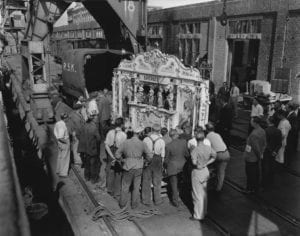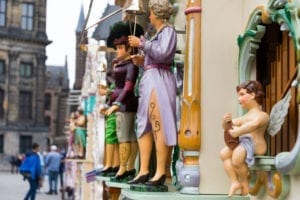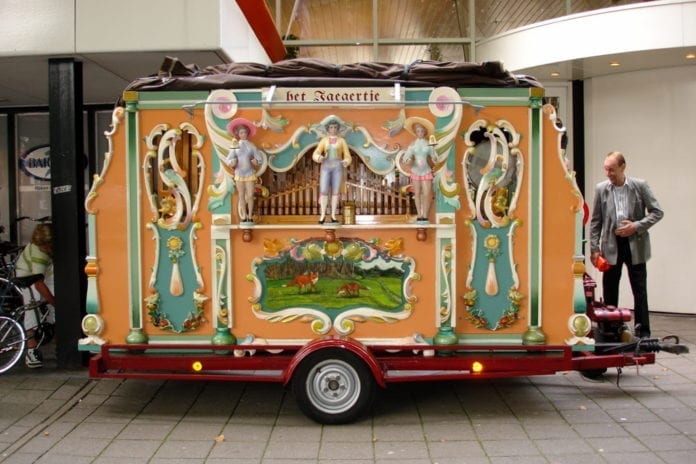Do you know that street barrel organ culture is unique to the Netherlands and this year makes it 145 years that it has been around? 1875 was when the first barrel organ company was founded on the Amsterdam Brouwersgracht. This is where street entertainers came to rent barrel organs. New ones were built as well as repaired in this very company.
Back then, many people got to listen to the latest top-hits through the barrel organ as it went through their neighborhoods in Amsterdam. Residents would come out of their houses to give some small change to the organ men. Today, despite not being as popular as it once was, the barrel organ is still very much an important piece of Dutch culture that must not be forgotten.
In many cities and villages in the Netherlands, the barrel organ is a well-known phenomenon. The barrel organ man can always be seen standing on a corner of the street with his instrument and a money box in hand while shaking the coins in his money box and gesturing to passersby to give him a coin (or two). Passersby can hear the music from afar, and the closer they get, the louder it becomes. Children even receive a coin from their parents which they are encouraged to drop in the barrel organ man’s money box. The culture around the street barrel organ is a typical Dutch one and if you’re visiting the Netherlands, it’s one you don’t want to miss.
History of the Dutch barrel organ

The history of the street barrel organ dates back to the 18th century. Around 1720, the so-called canary organs or serinettes were very popular. These were mechanical musical instruments consisting of small barrel organs. The serinette was first used by street musicians in Italy. Later on, many Italian street musicians travelled to other countries with their barrel organ, thus ensuring a rapid spread of this form of street music. They would start a trend that would become popular in Germany and France. Many street performers saw it as a welcomed form of entertainment because it meant that they did not have to play a musical instrument in order to entertain their audiences.
The barrel organ became a popular form of entertainment in the Netherlands when Leon Warnies, a Belgian started a street organ rental business in 1875. He bought good organs in France and Germany and started renting it out to street performers who wanted to take advantage of the popularity of the musical instrument in making some money. Soon, the people who went to Leon Warnies to rent organs were no longer referred to as street musicians roaming the country for an easy coin. They organised themselves, got permanent residence in Amsterdam and also acquired a permanent permit from the municipality to entertain crowds with their instruments in certain parts of the city. This gave birth to the Dutch word “Pierement” which soon became every street entertainer’s dream!
The Golden days of the “Pierement”

The “Pierement” is another word for a street barrel organ. This means that not all pipe and barrel organs are a pierement. The Perlee family is the most popular and oldest barrel organ family in the Netherlands. Their company still exists to this day and is located in the Westerstraat, somewhere in the Jordaan area of Amsterdam. Their company was founded in 1875 and is now called the Gijs Perlee Draaiorgelmuseum Amsterdam. Some of the old and historical barrel organs can still be found there and most of are even operational! New organs are still being built and old ones restored with tools from the 19th century.
A visit to the museum is well worth it as their unique feature is the ability to bring the barrel organ glory days to life. A time when the gramophone could not yet be found in every living room and often still had poor sound quality. For ‘the ordinary man’ the street organ was often the only way to discover new music or be entertained even if for a while.
The Decline of the Street Barrel Organ
Despite being one of the most popular forms of entertainment in a lot of Dutch cities, a drastic change occurred after 1930. An important cause was the rapid spread of the radio and gramophone in Dutch homes. A lot of people lost interest in the barrel organs and only true enthusiasts remained faithful to the musical instrument. In Amsterdam for example, it went downhill after 1935 and unfortunately, this was not due to the quality of the organs but rules surrounding barrel organs made by the municipal government. Amsterdam had to become a “modern city” and people found the street barrel organ to be an outdated form of entertainment. This led to the municipality implementing a ‘policy of extinction’ as regards to the barrel organs. They stopped issuing new permits to organ street entertainers and as a result, the numbers dwindled through the years. In 1937, the barrel organ was banned in the entire inner city. Gradually, the golden days of the pierement were over for Amsterdam.
WWII
When WWII broke out in 1940, the occupying German forces initially didn’t have any plans for the barrel organs. They didn’t even listen to it and actually thought that the street entertainers only used them to beg for money. Let into the regime in 1942, the Germans forbade all music on the street. They felt that people had to use their time in a useful way and playing with an organ was not considered “useful”. For a number of barrel organ owners, the ban on playing the instrument became the reason why they had to sell all their organs.
After the liberation of the Netherlands from the Germans, it turned out that most barrel organs had survived the war but their glory days were far behind them. The large Belgian organ factories no longer existed except for two, but they only built modern musical instruments (like jukeboxes) for cafés. The barrel organ had become a thing of the past, something that some group of enthusiasts didn’t like at all! In order to prevent a collapse of the Dutch barrel organ culture and to preserve the remaining organs in the Netherlands, they founded De Kring van Draaiorgelvrienden (KDV) in 1954.
Speaking about the liberation of Holland:
The association is committed to generating interest for the appreciation and preservation of the Dutch barrel organ culture. They also advise the relevant authorities on policy regarding permits for street barrel organ entertainers, subsidy for festivals and other activities that have to do with barrel organs, support for the preservation or establishment of barrel organs in different cities, funding for museums and all other issues related to barrel organs. De Kring van Draaiorgelvrienden has always emphasised the importance of the barrel organ to Dutch culture and how they are a historically and culturally important phenomenon that deserves protection by the Dutch government.
Present Day

If we look at the identity of the Netherlands to the outside world, we could say that it consists of the following elements: cheese, tulips, clogs, tulips, bicycles, windmills and of course, barrel organs. Tourists, especially non-Europeans, are very fond of it. They like to be photographed with a barrel organ in the background. For Amsterdam residents or visitors, Dams Square and/or Klaverstraat is where you’re sure to sometimes hear a very familiar sound in the city — a barrel organ. The present barrel organs on the street are only a shadow of those beautiful large ones from the glory days, but sometimes, during the summer months, if you’re lucky, you may just stumble upon a street entertainer with those big ones.
In Leiden, the Leidse Draaiorgeldag has gradually become a tradition. This is a day when the large and beautiful Hooglandse Kerk is completely filled with barrel organs, which all alternately play a tune for the inhabitant and visitors to enjoy. Imagine those deep sound waves vibrating through the old walls of the big and magnificent Gothic church! Sounds like something you definitely don’t want to miss!
In Utrecht’s Museum Speelklok, you can still find some barrel organs that, after a thorough restoration, sound just exactly how they used to in the past. If you want to compare the different types of street barrel organs, you can go to the events organised by the De Kring van Draaiorgelvrienden in various towns and cities in the Netherlands. Apart from a few street entertainers remaining, there are also a handful of museums.
The Draaiorgelmuseum in Haarlem is managed by the Stichting Het Kunkels Orgel. The founders of the museum took over the large Marenghi/Carl Frei dance organ in 1958. After more than 10 years of restoration, the organ has become a ‘must see’ in the museum that opened its doors in 1969 in an old factory at the Werfstraat in Haarlem. In the museum, visitors can see and listen to a collection of historically interesting barrel organs, the oldest of which dates back to 1900.
The Dutch Street organ culture is unique to the Netherlands and can not be found anywhere else in the world. A lot of things about a typical Dutch barrel organ can be described as fascinating. From the decorations – ornate dolls with bells painted in different colours to beautifully designed pastel shades meant to wow audiences. Behind these decorations are the barrel organ pipes that produce the beautiful music people hear. One would not be exaggerating if they said that Dutch barrel organs are more than just musical instruments. They are a phenomenon that the sands of time have refused to forget. because of how much they have contributed to Dutch culture. Who knows? Maybe one day, they will be added to the Unesco World Heritage List.
Until then, geniet van wat draaiorgelmuziek!
I’ll admit when I first walked past one I had no idea what it was until it started making music… Even then I didn’t really understand. There are all sorts of funny Dutch pastimes and items to discover. Like some of these…
Like this video? Want to see more about typically Dutch items or start learning Dutch? Then head over to Bart de Pau’s YouTube-channel (Learn Dutch) and get started!
Do you like the sound of the Dutch barrel organ? Let us know in the comments!
